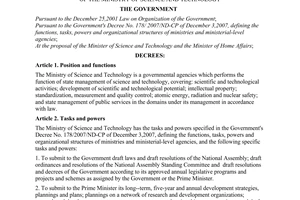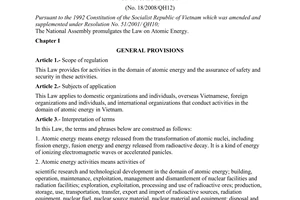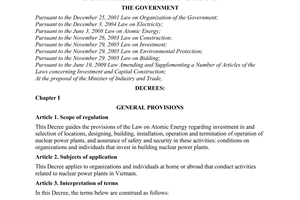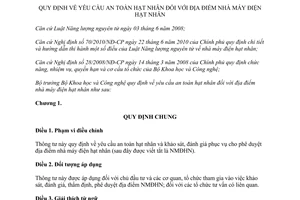Nội dung toàn văn Circular No. 28/2011/TT-BKHCN defining on nuclear safety requirements for locati
|
MINISTRY
OF SCIENCE AND TECHNOLOGY |
SOCIALIST
REPUBLIC OF VIETNAM |
|
No.: 28/2011/TT-BKHCN |
Hanoi, October 28, 2011 |
CIRCULAR
DEFINING ON NUCLEAR SAFETY REQUIREMENTS FOR LOCATIONS OF NUCLEAR POWER PLANTS
Pursuant to the Law on Atomic Energy dated June 03, 2008;
Pursuant to the Decree No.70/2010/ND-CP dated June 22, 2010 of the Government detailing and guiding the implementation of a number of Articles of the Law on Atomic Energy of Nuclear Power Plants;
Pursuant to the Decree No.28/2008/ND-CP dated March 14, 2008 of the Government providing for function, duties, authorities of organizational structure of the Ministry of Science and Technology;
The Minister of Science and Technology defines on nuclear safety requirements for locations of nuclear power plants as follows:
Chapter 1.
GENERAL PROVISIONS
Article 1. Scope of governing
This Circular provides on nuclear safety requirements and survey and assessment for approval of the locations of nuclear power plants (hereinafter abbreviated as NPP).
Article 2. Subjects of application
This Circular applies to investors and the agencies and organizations involved in the survey, assessment, appraisal, and approval of locations of NPP; for the concerned consulting organizations.
Article 3. Interpretation of terms
In this Circular, the following terms shall be construed as follows:
1. Design bases including the conditions, processes, factors caused by nature or human being, are considered explicitly as designing NPP, so that when such conditions, processes, factors appear, the safety system of NPP still operates as designed, the margin of safety approved by the competent agencies is secured.
2. Disadvantage conditions mean the conditions, processes, factors caused by nature or humans likely to generate problems for NPP.
3. Active faults mean the tectonic faults that can cause movement on or near the ground.
4. Karst means a combination of processes and geological phenomena appearing on the surface or in the ground mainly due to chemical dissolution of stony ground, forming the hollow cave, destroying and transforming the structure, status of stony ground, groundwater mechanism, specific topography, and hydrographic network mechanisms.
5. Problems in the design mean the conditions, processes and nature and man-made elements that can raise the problems considered in the design.
Chapter 2.
GENERAL REQUIREMENTS OF NUCLEAR SAFETY FOR LOCATIONS OF NUCLEAR POWER PLANTS
Article 4. The principles in assessment of locations
1. Locations where are assessed suitable for the construction of NPP, if they simultaneously satisfy the following conditions:
a) Having ability to ensure the safety for NPP during normal operating conditions as well as appearing problems in the design;
b) Having ability to ensure humans and environment not being affected by hazards of radiation in normal operating conditions as well as appearing problems in the design;
c) Being limited the harm to humans and the environment in case of occurring the incidents beyond the limit considered in the design (hereinafter referred to as incidents outside the design).
2. When assessing the location of NPP, it must survey and study all the following factors, the characteristics:
a) The natural and artificial elements likely impact from outside to the safety of NPP;
b) The characteristics of location and environment related to radiation emission from NPP causing harm to humans and the environment;
c) Density, population distribution and characteristics of the area related to the ability to implement incident response measures.
3. Where the assessment as prescribed in clause 2 of this Article considers that location having one of the hereunder characteristics, shall not be accepted:
a) Having active faults;
b) Having ability of ground vibrations caused by earthquakes, with the peak ground acceleration (PGA) obtaining value of 360 cm/ s2 or more, with repeat cycle of 10,000 years;
c) Having karst which is developing or karst which is creating cone with a diameter of larger than 20 m on the ground.
4. Where the assessment as prescribed in clause 2 of this Article shows that, in addition to the characteristics as specified in clause 3 of this Article, the location also has the other disadvantage conditions that cannot be overcome by measures of design, protection measures or administrative regulations, the location is not accepted.
Article 5. Surveys and research of location
1. Conduct the survey, research of characteristics of the location, the relevant factors and determine their level of hazard under the following provisions:
a) Survey and study the characteristics of the location that can affect the safety of NPP, including earthquake, surface fault, volcanism, weather, floods, tsunamis, geo-technique, the factors caused by human activities, cooling water and power supplying for the NPP;
b) Collect data of prehistory, history, the measured, recorded data on the number of occurrences and severity of the phenomena, important natural events for the safety assessment of NPP location. For seism, meteorology and hydrology, it must have data recorded, measured not older than 5 years old to the time of filing request for approval of location, including data of at least 12 months recorded, measured continuously and ensure reliability, accuracy and completion of time and recorded, measured data;
c) Forecast the change of characteristics likely to affect the safety of the NPP over a period of at least equal to the expected operation time of NPP;
d) Survey, study the frequency and extent of harm caused by natural and man-made factors that can affect the safety of the NPP;
đ) Use appropriate methods to determine the hazardous level of the factors likely to affect the safety of the NPP. The method used should be advanced and proven to be consistent with the characteristics of the area to be surveyed, assessed;
e) Use the specific data related to the location to determine the level of hazard. Where not collected specific data related to NPP’s location, can use data of other places with characteristics to be proved as equivalent to the characteristics of NPP’s location.
g) When surveying, studying the characteristics specified in point a of this clause, must choose to use parameters, parameter value in accordance with the determination of the hazardous level for the design of NPP;
h) Scope of the survey area, study and determination of the level of hazard of the natural and man-made elements must be proved to be large enough to cover all the important characteristics for determining the level of harms of phenomena, facts and in accordance with the specific methods used.
2. When surveying, studying to select and evaluate the locations must apply the standards of Vietnam. For the contents that Vietnam does not have standards, or has not yet had full standards or has not yet ensured synchrony, and then apply the standards of foreign countries permitted to apply by the competent agencies.
3. Activities and results of survey, research must be made into records for archiving and submitting to the competent State agencies as proposing the approval of the NPP’s location.
Article 6. The impact of nuclear power plants
1. Survey, study the environmental factors affecting the ability of radiation emissions from NPP including radiation emissions through air, surface water, and groundwater. The scope of the area of survey, study depends on the ability to spread radiation in case of normal operation of the NPP as well as in the case of incidents.
2. Determinate the ability of radiation impact on humans and the environment based on the basic design and the amount of radiation emitted in the case of normal operation of the NPP as well as in the case of having incidents need to make the plans of responding.
3. Identify and assess the direct and indirect radioactive emissions path from the NPP, the entire region in which human beings and the environment are likely to be harmful.
The identification and evaluation is done on the basis of the characteristics of the area, paying attention to the biosphere characteristics related to the accumulation and transport of atomic nucleus.
4. Assess the location in relation to the basic design of the NPP. The evaluation must be sufficient grounds to conclude that the radiation dose caused by the plant to the radiation workers and the public is limited to the lowest level can be achieved in a reasonable manner, not exceeding the limit as prescribed by law.
Article 7. Characteristics of the population and plans for incidents response
1. Research and evaluate the current and future characteristics and population distribution in the areas likely affected by radioactive emissions from the NPP. The research and evaluation must include assessment of use of land, water and placed in the relation to the specific characteristics related to the level of radioactive emissions causing harmful to humans.
2. Research and evaluate the possibility of establishing the region of incidents response around the location of the NPP on the basis of results of research, evaluation provided for in clause 1 of this Article and the characteristics related to the implementation of the incidents response plans, so that radiation dose caused by the plant to the public does not exceed the limit as prescribed by law.
Article 8. Observation of safety assurance
The observation of the elements and characteristics of locations related to the safety assurance to NPP, to human and environment is performed throughout the life cycle of the plant, including the monitoring of increase and population distribution.
Article 9. Quality assurance and examination, inspection of activities of survey, research, collection of data
1. When the investors and the concerned agencies and organizations conduct the activities of survey, research, collection of data for the evaluation of the locations, theu must make the following regulations:
a) Establish and implement quality assurance programs, specially paying attention to activities likely to affect the safety and the determination of the parameters for use as a basis for design;
b) Submit the plan to conduct the activities of survey, research, collection of data related to nuclear safety requirements with the NPP location to the agency on radiation safety and nuclear.
2. The agency on radiation safety and nuclear is responsible for examining, inspecting the activities of survey, research, collection of documents related to nuclear safety requirements for NPP location as prescribed by law.
Chapter 3.
SURVEY AND EVALUATION OF NATURAL CONDITIONS AND HUMAN ACTIVITIES RELATED TO LOCATION
Article 10. Earthquake, surface faults, volcano
1. Assess the harmful level of ground vibrations caused by earthquakes to the location, taking into account tectonic seismic features and the special conditions of the ground. Perform analysis of the reliability of the assessment results.
2. Research and evaluate the evidence of active faults, the possibility of volcanic activity, and their harmful levels to the safety of the NPP. The evaluation is done by the methods and survey, research of sufficient details to be able to make rational decisions.
Article 11. Meteorology
1. Survey and study the meteorological parameters and extreme meteorological phenomena that can affect the safety of the NPP, including lightning, tornados, hurricanes, and other weather phenomena locally.
2. The results of survey, research must be adequate and appropriate to the purposes of NPP design, including the assessment of the probability of occurrence of extreme meteorological phenomena having parameters beyond the design parameters.
Article 12. Flooding
Assessment of flooding ability at the location is under the following provisions:
1. Determine the cause by one or a combination of natural phenomena, including heavy rains, rising tide, waves, floods, and other phenomena. Where having the possibility of flooding affecting the safety of the NPP, it is required to collect; observe and analyze the necessary meteorological and hydrological data, including the collection and analysis of the historical data. For historical data, it must consider the relevance and reliability of data for assessment of location.
2. Analysis data related to the structure of water regulation system in the upstream that can contribute to potential flooding.
3. Build the appropriate pattern of meteorology, hydrology taking into account the limitation on the accuracy and the amount of data, the limitation on data collection time and the changes in the past of the relevant characteristics in the region.
Article 13. Tsunami
1. Evaluation generally the relevant area to determine the possibility of tsunami occurrence affecting the safety of NPP. Where having the possibility of tsunami occurrence affecting the safety of the NPP, it is required to collect; record, measure and analyze the necessary tectonic seismic data, including the collection and analysis of the pre-historical, historical data. For pre-historical, historical data, it must consider the relevance and reliability of data for assessment of location.
2. Based on the collected data and comparison such area with other areas having similar characteristics which have been studied adequately on the phenomenon of tsunamis, evaluated the frequency of occurrence, power of destruction and the tsunamis height to determine the harmful level, taking into account the characteristics of the coast causing increase of the harmful level.
3. Build the appropriate pattern of tsunami impact taking into account the limit on accuracy and the amount of data, the limit on data collection time and assessment on capabilities affecting the safety of NPP under the different scenarios.
Article 14. Geo-technique
1. Assess the instability of slope, landslides having affected the safety of the NPP. In case of the instability of slope affecting the safety of the NPP, it must determine the harmful level; use the parameters and the value of the specific ground vibration of the area.
2. Assess the ability of lifting, surface subsidence of the location caused by the natural and artificial factors such as caves, karst formations, mines, water wells, oil wells on the basis of using geological maps and appropriate data.
3. Assess the possibility of ground liquefaction at the location on the basis of using the parameters and the value of ground vibrations; use stony ground survey methods and the appropriate analytical methods to determine the harmful level of ground liquefaction for NPP.
4. The geotechnical characteristics of the ground, regime, and chemical properties of groundwater must be surveyed and researched. The layers of rocks at the location must be identified and described in the form suitable to the purpose of design. The stability of the foundation under the affect of static loads and seismic loads must be assessed.
Article 15. The factors caused by human activities
1. Assess the ability of plane falling at the NPP location and the harmful level, taking into account the frequency of flights and flight characteristics of present and future. In case of having ability of plane falling at the location, it must determine the harmful level
to the NPP.
2. Identify the activities in the area related to the handling, storage, and transport of chemicals that can cause explosions or generate flammable, explosive gases. Determination of harmful level due to chemicals explosion, including impact cause by pressure and toxicity takes into account the distance to the location.
Article 16. Cooling water source and power supplying for the nuclear power plants
1. Assessment of parameters of location related to water supply for cooling the NPP, includes:
a) Temperature and humidity of air;
b) Water temperature;
c) Water sources with the data on flow, minimum water reserve, the period of time that water source is at the minimum reserve, taking into account the possibility of damage of the water regulation structures.
2. Identify the reasons of degrading or change of the nature of cooling water supplied to the NPP because of nature or operations of humans such as change or block of the flow of rivers, lakes drain, and generation of a large amount of impurities or sea creature, oil spills, fires.
3. Determine the power supplying to the structures, systems, and the important components to the safety of the NPP.
Chapter 4.
SURVEY AND EVALUATION OF THE POSSIBILITY OF RADIO ACTION EMISSION FROM THE NUCLEAR POWER PLANT AFFECTING THE PUBLIC
Article 17. Radiation emission through the air
1. Survey, research meteorology and other concerned factors, including topography, the phenomena and basic meteorological parameters such as heavy rain, humidity, speed and direction of wind, air temperature, the stability and turbulence of the air.
2. Implement the meteorological observation programs in the location and the related areas for the assessment of radiation spread through the air. Use the observation equipment capable of recording, measuring the meteorological parameters at the heigh and the appropriate location. The identification of areas for observation and placing of the observation devices depend on the topographic characteristics, meteorology. In addition to observation data, it must collect meteorological data which are available from other sources.
3. Assess radioactive emissions through the air on the basis of using data collected and the appropriate emission pattern. The emission pattern is required to take into account the topographic characteristics of the location and relevant area affecting the emission of radiation through the air, the characteristics of the NPP presented in the basic design.
Article 18. Radiation emission through the surface water
1. Survey and study the characteristics of surface water in areas related to the ability to spread radiation through surface water, including natural and artificial water resources, the main structures for water source control, the location to install structure of taking water and the use of surface water sources in the area.
2. Perform the programs of survey, study of surface water to determine the ability of dilution and diffusion of water sources, the ability of gathering sediment and creatures, mechanisms of radiation transport in the hydrosphere and the path causing radiation exposure.
3. Assess the influence ability of contaminated surface water for residents on the basis of using data collected and the appropriate emission pattern.
Article 19. Radiation emission through groundwater
1. Survey and study the characteristics of groundwater in the areas related to the ability to spread radiation through ground water, including water source features, their interaction with surface water, and the groundwater use in the area.
2. Perform the program of survey, study, and analysis of the characteristics of the groundwater to evaluate the mechanism of transport of atomic nucleus. This program must include the survey and study of the characteristics of soil, water, chemical and physical properties of the materials in the soil related to the mechanism of accumulation and transport of atomic nucleus in groundwater and the path causing radiation exposure.
3. Assess the effects of contaminated ground water for residents on the basis of using data collected and the appropriate emission pattern.
Article 20. Population distribution and the radiation background
1. Identify data on population distribution based on the latest census and extrapolation to have the data of the present and future for the areas where the population can be affected by radioactive emission. If there is insufficient reliable data, it must be surveyed, studied additionally. The data must be analyzed to determine the population distribution according to the direction and distance to the NPP. Assess the effects of radiation on the population in terms of normal radioactive emissions and in case of problems, including extremely serious problem, taking into account the typical parameters of the location.
2. Assess background of radiation in the atmosphere, hydrosphere, lithosphere, and biota in the region for use as a basis for determining the radioactive effects of the NPP in the future.
Article 21. Radiation dose limit for the public
The location chosen must ensure:
1. In the case of normal operation of the NPP, radiation dose caused by the plant to the public does not exceed the limits as prescribed by law.
2. In the case of incidents, the incident response plan can be done for the radiation dose caused by the plant to the public not exceeding the limits as prescribed by law.
Chapter 5.
IMPLEMENTATION PROVISIONS
Article 22. Effect
1. This Circular takes effect as from December 15, 2011.
2. In the course of implementation, if any problem arises, the agencies, organizations and individuals should promptly report to the Ministry of Science and Technology for consideration of amendment and supplement./.
|
|
FOR
MINISTER |
------------------------------------------------------------------------------------------------------
This translation is made by LawSoft and
for reference purposes only. Its copyright is owned by LawSoft
and protected under Clause 2, Article 14 of the Law on Intellectual Property.Your comments are always welcomed



